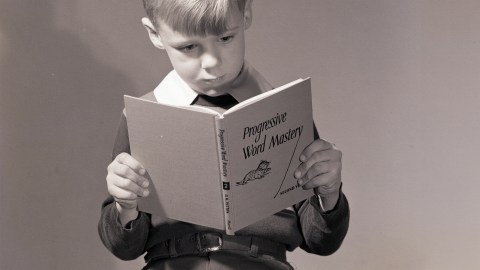The invention of the gifted child

A new minority was defined in the wake of the Supreme Court’s 1954 Brown v. Board of Education desegregation decision. Academically “gifted” children, as measured by IQ scores, became a focus of national concern. In April 1958, for instance, Life magazine warned of the “waste of fine minds” in a profile of young geniuses like the eleven-year-old Iowan with an IQ of 162 who was bored out of his mind at school—all while the Soviets were beating our pants off in the Space Race! To meet Cold War challenges, schools needed to be systematically restructured to provide for what James Bryant Conant, in his much-ballyhooed study The American High School (1959), called the “native ability” of students.
In Brown, the NAACP’s lawyers presented evidence that segregated education psychologically harmed Black children. Advocates of high IQ students gave this SCOTUS-successful argument a spin of their own: the “academically talented” (the top 15 percent according to Conant) and especially the “gifted” (the top 2–3 percent) were in danger of being psychologically damaged by isolation and neglect in schools that taught to the average.
With the launch of Sputnik in October 1957, all this was perceived as a matter of national security.
Historian Jim Wynter Porter explores how the effort to reform high school and expand science education through the National Defense Education Act (NDEA) of 1958 meshed with white anxiety about the desegregation of schools. Advance placement, college prep, and other gifted and talented programs would turn out to be filled with students who were overwhelmingly white and wealthy—yet this was viewed as separation by “intelligence,” not segregation by race.
Indeed, race went studiously unmentioned by advocates of gifted students and the testing required to identify them. After all, the race “science” and IQ testing of the 1920s and 1930s had been murderously discredited by the Nazis. Prewar obsessions over “subnormality” were replaced with postwar fascinations over “supernormality.” Intelligence was now defined as an individual, not a group or racial, trait. Any boy or girl could be an academic superstar, so schools could and should be legitimately divided by natural ability, with the top 15 percent in college prep and the rest tracked into “more appropriate” channels.
The Reds, after all, had to be caught up with and overtaken in science and technology—even as American schools were reorganized to “structure inequality.”
“Given the cultural biases of tests and starkly racial disparities in educational opportunity,” writes Porter, “systematic expansion of school testing could still accomplish (but now, in the name of a science race with the Soviets, one individual at a time) the work of ‘race’ without ever having to say its name.”
Southern states in revolt against Brown quickly grasped the implications of IQ-based gifted programs. (Porter’s book on this topic, in press, is tellingly entitled Safeguarding Whiteness). The state of Virginia’s “massive resistance” to desegregation included closing public schools completely for years rather than integrating them. Virginia was also the first state to adopt the Educational Testing Service (ETS) National Guidance Testing Program in 1959. Georgia also pioneered another new ETS testing regime in 1960. (Porter points to the networks linking boosters like Conant and ETS, nominally a nonprofit but also a monopoly.)
The “call to reorganize schools around talent” wasn’t just heard in the South. It was taken up in places where residential segregation resulted in de facto school segregation. The “discourse on ‘academic talent’ could carry ‘race’ as a stowaway within in it,” writes Porter. The reformulation of “intelligence” in the post-WWII era entangled “race and individualism and all the other social identities that individuality could subsume.” (Although outside the scope of his article, Porter suggests the same moment may have reinforced already male-dominated professions in the sciences and engineering.)
Notably, Porter writes, all the concern about isolating the talented and gifted vanished as they were separated from their school mates into special classes and programs.
The legacy of the Brown/Sputnik/NDEA era continues to this day, writes Porter, “with disproportionate numbers of whites and affluent students enrolled in rigorous college prepatory curricula” while other school systems are characterized by “chronic underfunding, inequitable funding, and an unhealthy, indeed extravagant overreliance on standardized tests.”
This article appeared on JSTOR Daily, where news meets its scholarly match.





